
By Steve W. Ross - UNC-Wilmington, Center for Marine Science
August 27, 2012
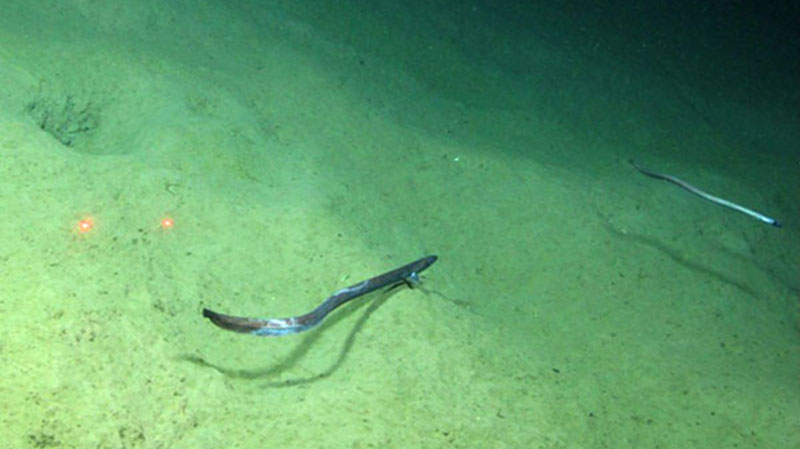
Cutthroat eels at about 800 m cruise along the soft sandy bottom. Image courtesy of Deepwater Canyons 2012 Expedition, NOAA-OER/BOEM. Download image (jpg, 54 KB).
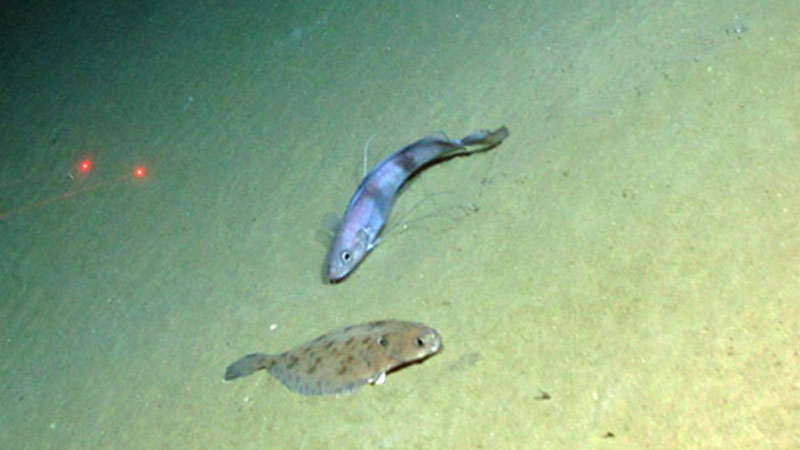
A witch flounder and longfin hake share the bottom. Image courtesy of Deepwater Canyons 2012 Expedition, NOAA-OER/BOEM. Download image (jpg, 57 KB).
Although we have not yet completed our mission in the mid-Atlantic canyons, we have sampled a large amount of the bottom and have so far documented a great variety of fishes. Most of the continental slope fishes in this area are well known to science, but many may not have been seen in life, displaying numerous color patterns and a variety of behaviors. This view available from the ROV cameras of the living fishes in their habitats is a unique perspective and provides invaluable information. So far with the ROV we have covered an overall depth range of about 1000 to 280 meters, and have probably seen over 30 species of fishes. While sand/mud is the dominant bottom type in these canyons, there are also large areas of consolidated (hard) mud walls some of which are vertical and cover over 50-100 m of depth. Various types of hard rocks also are scattered about the canyon. Wherever there is structure (even anemone fields) there are numerous fishes using that structure.
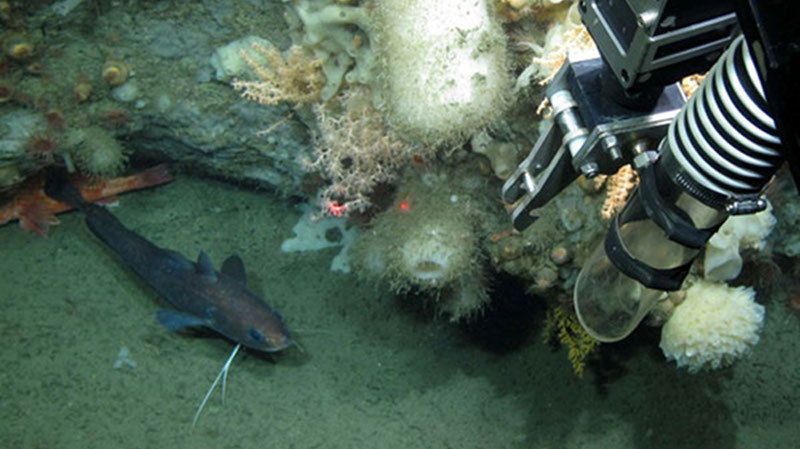
Longfin hake use both walls and reef type habitat for shelter. Image courtesy of Deepwater Canyons 2012 Expedition, NOAA-OER/BOEM. Download image (jpg, 80 KB).
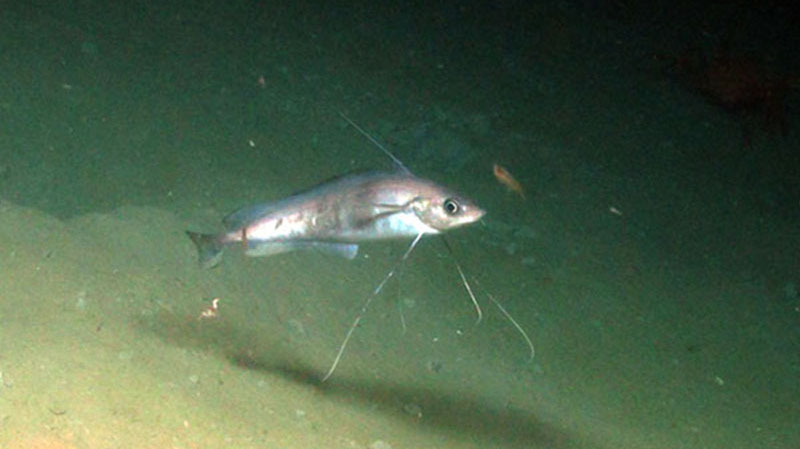
Longfin hake are equally adapted to swim along the open soft substrate. Image courtesy of Deepwater Canyons 2012 Expedition, NOAA-OER/BOEM. Download image (jpg, 85 KB).
Over the soft bottom, especially deeper than 400 m, cutthroat eels (Synaphobranchidae) are very common. Witch flounder (Glyptocephalus cynoglossus), goosefish (probably Lophius americanus but there are other species out here), longfin hake (Phycis chesteri), silver hake (Merluccius sp.), rattails (Nezumia spp.) skates, and wolf eelpout (Lycencheyls verrillii) are also frequently noted along our soft bottom transects. When we encounter more complex habitats (fields of anemones and burrows, holes, rocky areas), such fishes as roughys (Hoplostethus sp.), blackbelly rosefish (Helicolenus dactylopterus), alphonsino (Beryx sp.), cusk (Brosme brosme), longfin hake, codlings (Laemonema sp.) and an unidentified type of brotula become more common. There is a lot of overlap in habitat usage with the fishes, but some species definitely have preferences. For example, the small brotulas (Bythididae) sticky tightly to the branches of the large Paragorgia (bubblegum) corals, while hagfish, flatfish, and eels are most common on the sand/mud bottoms.
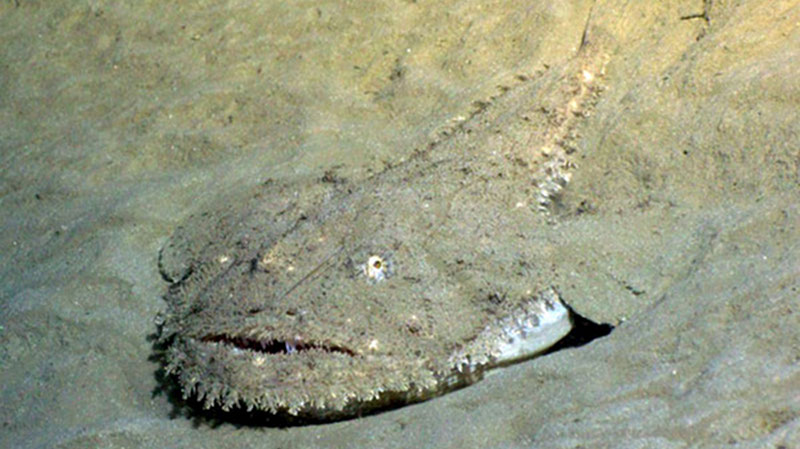
A goosefish is well camouflaged in any habitat. Image courtesy of Deepwater Canyons 2012 Expedition, NOAA-OER/BOEM. Download image (jpg, 91 KB).

The rattail, Nezumia sp. is a common fish at most depths. Image courtesy of Deepwater Canyons 2012 Expedition, NOAA-OER/BOEM. Download image (jpg, 75 KB).
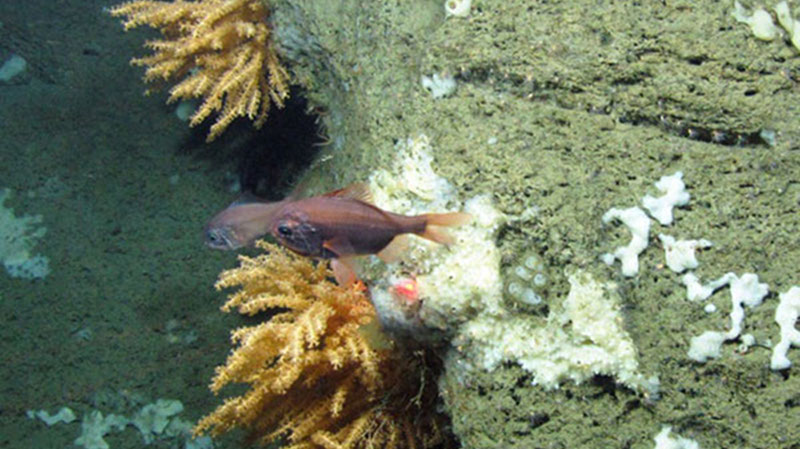
Roughies can occur along the vertical walls in singles or pairs. Image courtesy of Deepwater Canyons 2012 Expedition, NOAA-OER/BOEM. Download image (jpg, 105 KB).
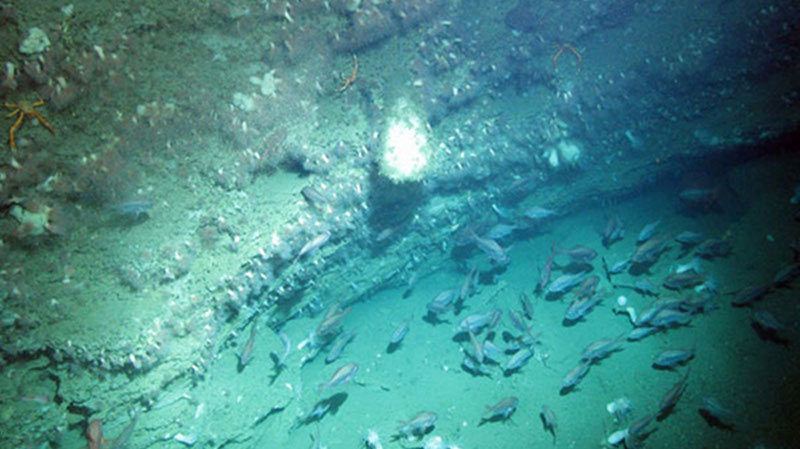
Roughies can occur along the vertical walls in singles or pairs (left), but we have also seen very large aggregations in places in Baltimore Canyon Image courtesy of Deepwater Canyons 2012 Expedition, NOAA-OER/BOEM. Download image (jpg, 85 KB).
One of the more unusual fishes we observed was an armored searobin (Peristedion sp.) walking along the bottom using its pelvic fin filaments as legs and its chin barbels as feelers for food. Just off the bottom bright silver barracudinas (Paralepedidae) hover in a head up position. We have been visited twice on the bottom by very large sharks, including a hammerhead. There appears to be a lot of potential food items for fishes in the canyon as we see huge swarms of amphipods and krill stirred up from the bottom sediments. On the surface almost every day we have seen sport fishing boats trolling along the canyon which is also a testament to the abundance of fishes in this area. As the cruise continues, we expect to add to our list of fishes and to record new data on their distributions and behaviors.

This armored searobin (Peristedion sp.) is one of the more interesting fishes we see at the shallower depths (usually above 320 m). Image courtesy of Deepwater Canyons 2012 Expedition, NOAA-OER/BOEM. Download image (jpg, 80 KB).

We only had a passing view of this large hammerhead shark as it cruised by the bow of the ROV. Image courtesy of Deepwater Canyons 2012 Expedition, NOAA-OER/BOEM. Download image (jpg, 45 KB).
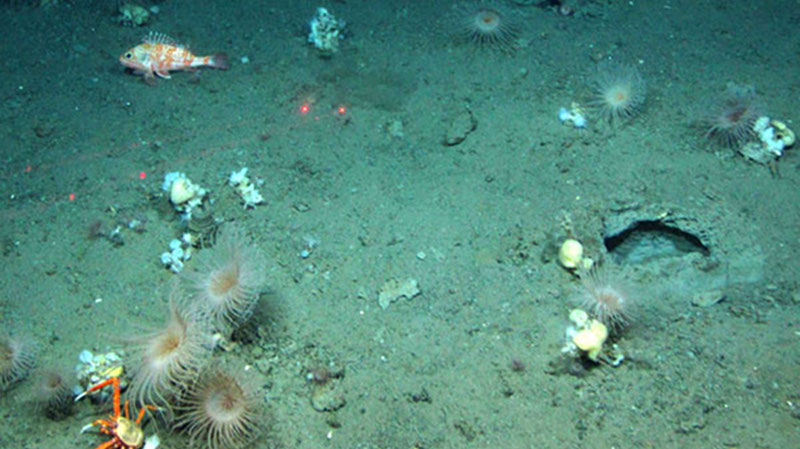
A blackbelly rosefish perches in a field of anemones and sponges at about 350 m depth in Baltimore Canyon. Image courtesy of Deepwater Canyons 2012 Expedition, NOAA-OER/BOEM. Download image (jpg, 92 KB).